| This is a picture of a hock lock. A video of this procedure is found below. |
Introduction:
Unless males are to be kept for breeding purposes, they should be castrated very early in life (about 1-2 weeks of age; some goats at 2-4 days of age). It is best to work early in the morning when the weather is not too cold and when the sun is shining brightly. Should weather conditions change to rain or snow soon after, the animals should not be allowed out in these conditions. With animals born in the warmer months, a clean pasture is the ideal place to turn them after castrating. With animals that will be kept inside after castration, change the bedding of the animals prior to or immediately after castrating. Because castrating is usually a surgical procedure, proper sanitation is essential. Clean all instruments and soak them (including elastrator bands) in a disinfectant (chlorhexidine) for at least 10 minutes before beginning the procedure. Dip or soak the instruments in chlorhexidine between each castration. If flies are a problem when the lambs or kids are being castrated, place fly repellent on the wound and saturate the wool/hair around the wound with the repellent. Watch closely for evidence of fly strike. Because tetanus is often a problem, many producers give lambs/kids 150-250 units of tetanus antitoxin (500-750 units to adults) before they are castrated. This is essential in lambs/kids that are from unvaccinated mothers or in adults with an unknown vaccination history.Reasons for Castrating:
When to Castrate: The preferable age for castration is 2-21 days. To help reduce the stress placed on the animal, many producers prefer to castrate at 2-4 days. These animals will generally be playing and jumping the next day. Complications can arise when lambs/kids are allowed to get 4 to 6 weeks old before they are castrated or if they are castrated during the height of the fly season. Animals (particularly goats) several months old often require anesthesia to safely perform a castration. Some studies recommend waiting to castrate male goats that are going to be kept as pet wethers until after they reach puberty. This allows the diameter of the urethra to be as large as possible to help prevent urinary stones.
How to Castrate: The time-honored method of castration in sheep where the testicles are removed by the teeth of the producer will probably never be replaced. In addition to this method, there are several instruments that are commonly used to remove the testicles. Many of these instruments and techniques are discussed in the following information.
Restraint: For small animals, the holder places the lamb/kid on its rump (dock) in a sitting position with the four legs properly held and spread apart. Both hind legs are inside the front leg of the corresponding side, and the holder’s four fingers circle the hind leg (all above the hock) while the thumb circles the front legs at the knee. This particular restraint is called the "hock-lock." Only a lamb/kid that is too large will have enough strength to kick out of the holder’s grasp. When castrating a lamb, he should be slightly tilted back on the shelf/table so that the tail can be held by the body of the person doing the castrating. This will force the lamb’s back to straighten and make it easier to get at the testicles once the scrotum is opened. Larger animals are often tranquilized and held in a standing position.
|
|
If the video
does not play, you must install an MPEG video |
Surgical Castration:
Knife, Fingers, and Teeth:
Cut the lower one-third of the scrotum completely off using a sharp pocket knife or blade. The scrotum can be cut with one slice if it is pulled away from the body and stretched with one hand while cutting with the other. After each use, the knife should be soaked in chlorhexidine solution. To help prevent infection, latex gloves can be worn and changed often. The thumb and first finger are used to push the testicles out by pressing at the base of the testicles where the cord can be felt as it enters the abdomen. The end of each testicle is then grasped with fingers or teeth and pulled away from the lamb or kid with gentle pressure. The hand not holding the testicle can be used to help strip the tissues surrounding the testicle back towards the animal’s body. Once the testicle is freed, gentle pulling force can be used to completely remove the rest of the cord from the body. Some testicles may require some "blunt" dissection before they can be removed. The back side of the knife’s blade is used to place pressure on the cord and "peel" away any remaining tissues, while pulling force weakens and eventually ruptures the cord. A knife should never be used to cut the cord directly. This will result in excessive bleeding. It is much better to rupture or tear the cord, instead of cutting it with a knife.When grasping the testicles with the teeth, a tight grip should be taken about 3/8 to 1/2 inch above the end of the testicle. If gripped too close to the tip, the outer tissues (tunica) may only be pulled and a second attempt will have to be made to get the testicles. In very young animals, speed can be attained by pulling both testicles at once. Some producers prefer to pull one at a time, which is perhaps easier on the lamb or kid. There is much less danger of infection when the teeth are used instead of dirty fingers to grasp the testicles. Further, when this method is performed by experienced persons, it can be very fast.
* The main disadvantage of the surgical method is that lambs or kids will occasionally die from hemorrhage or infection.
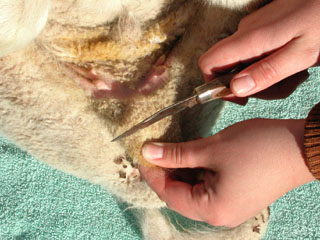 |
|
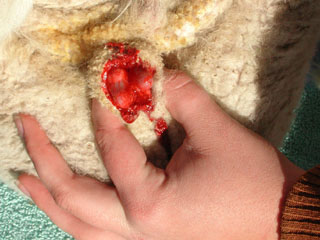 |
|
|
If the video
does not play, you must install an MPEG video |
|
If the video
does not play, you must install an MPEG video |
All-In-One: Similar to the knife method, the All-In-One scissors-like
instrument is used to cut off the bottom third of the scrotum. The grippers on
the end of the scissors work as pinchers to pull the testicles from the scrotum.
This method is popular with producers that prefer not to use their teeth.
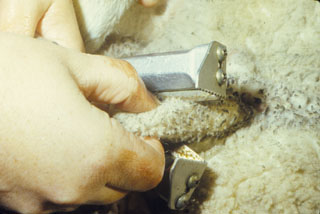 |
|
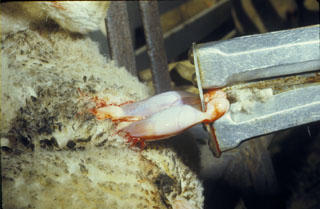 |
|
Bloodless Castration:
Several instruments are available that can be used instead of actually cutting the scrotum. The Elastrator and the Burdizzo bloodless castration instruments are two of the most common. Both can be used for docking lambs as well; however, the Burdizzo may loose its crushing ability if it is used for docking tails and then to castrate. The Burdizzo was quite popular at one time, but because of careless application that resulted in a high number of semi-castrated animals, it is not used as often for castrating. This instrument also requires more skill to properly use and often takes more time to castrate the lamb or goat than any of the other methods.
Elastrator: This method involves using rubber rings (bands) that are applied above the testicles by a tool that stretches the ring as it is placed in position. After the ring is placed, it cuts off the circulation in the scrotum (or in the tail when docking sheep) and the testicles and scrotum eventually fall off. This procedure can be done safely in any weather; however, animals are in pain and discomfort longer with this method than with those methods previously mentioned. This method is probably most efficient when used on newborns or very young animals. The older the animal, the more chance there is for complications. Tetanus infection is a potential risk from this method of castration. A vaccination with a shot that includes Clostridium tetani is highly recommended in all animals castrated using this method.
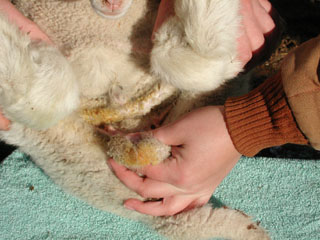 |
|
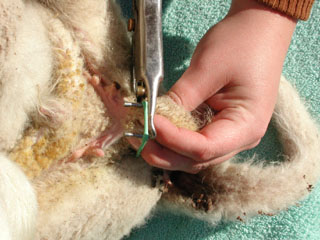 |
|
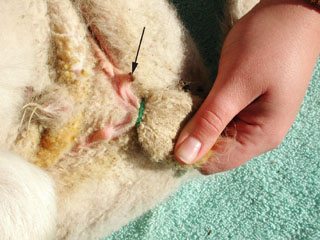 |
|
|
If the video
does not play, you must install an MPEG video |
Burdizzo (emasculatome): This instrument will sever the cord without
breaking the skin of the scrotum. The testicles then shrink (atrophy) and
disappear in 1-2 months. The main objection to this method is that
occasionally the producer will miss one of the cords and the testicle will
continue to develop. There is also the danger of crushing too low, leaving
testicular tissue that will continue to develop. When the Burdizzo is used too
high on the scrotum, the urethra may be crushed and the animal will die. Some
producers crush the cord twice about 1 cm apart. This may help ensure that the
cord is completely severed. This procedure should not be performed on large
animals because the extra tissue around each cord will prevent adequate
crushing. Apply the Burdizzo to only one cord at a time. This can be
accomplished by working one of the cords to the side of the scrotum and then
applying the Burdizzo. The Burdizzo should not be applied across the entire
scrotum in an attempt to sever both cords in one operation.